
95% of researchers rate our articles as excellent or good
Learn more about the work of our research integrity team to safeguard the quality of each article we publish.
Find out more
ORIGINAL RESEARCH article
Front. Soil Sci. , 24 March 2025
Sec. Plant-Soil Interactions
Volume 5 - 2025 | https://doi.org/10.3389/fsoil.2025.1556283
Background: The application of organic fertilizers not only stimulates cauliflower growth and development but also helps to attain sustainable improvement of soil health. A field experiment was conducted in Chitwan, Nepal from December to March of 2022 and 2023 to explore the effect of different organic fertilizers on the growth, development, and yield of cauliflower.
Methods: This study also analyzed the changes in soil physicochemical properties on sandy loam soil. The research was taken in a one factorial Randomized Complete Block Design (RCBD) with three replications. MS Excel and R-studio were used to analyze the obtained data.
Results: After the research, the plant height (54.24 cm), leaf length (42.33 cm), curd diameter (18.26 cm), curd height (11.03 cm), and yield (41.91 t/ha) were significantly higher when poultry manure was applied at 4.63 t/ha in the soil. Similarly, the application of poultry manure revealed significantly higher organic matter (3.93%), total soil nitrogen (0.28%), and soil available phosphorous (110.04 kg/ha). In addition, soil available potassium (187.77 kg/ha) and soil pH (6.84) were seen significantly higher in goat manure (18.94 t/ha) and obifert (10.36 t/ha) respectively which were statistically similar to poultry manure.
Conclusion: Application of organic fertilizers was shown to be beneficial; nevertheless, in the long run, poultry manure (4.63 t/ha) can be recommended for sandy loam soil and similar environmental conditions present at the study site to improve cauliflower performance and overall health of the soil.
Fertilizers serve a crucial role in crop production and productivity. However, the constant and indiscriminate use of chemical fertilizers has a detrimental impact on crop yield and soil health (1). As a result, the majority of the fertile soils became infertile, and the problems in soils rose due to excessive fertilizer use (2). Continuous utilization of inorganic fertilizers without organic supplements adversely affects the soil structure, water-holding capacity, moisture, bulk density, organic matter content, and soil microbial activity. These effects on the physical, chemical, and biological properties of soil lead to environmental pollution (3). In addition, global observations have confirmed a decrease in crop yields as a result of the ongoing utilization of inorganic fertilizers (4). Hence, there is a growing necessity to use organic fertilizer sources to rejuvenate soil health.
Organic fertilizers are those materials that are naturally derived from plant, animal, or microbial sources that are used to improve soil fertility and influence plant growth (5, 6). These manures are abundant in several micronutrients as well as important nutrients like nitrogen, phosphorus, and potassium (7). These include compost, animal dung, green manure, and biofertilizers. For a country like Nepal, transportation is difficult, and the chemical fertilizer supply is entirely dependent on imports (8). The manufacturing and use of organic fertilizer at the local level is critical for following sustainable agricultural practices. In Nepal, most of the farmers in rural areas prefer to use animal dung for other organic fertilizers (9). Organic fertilizers, as opposed to synthetic fertilizers gradually release nutrients into the soil, encouraging environmentally friendly farming practices. It ultimately lowers the chance of pollution (3). Additionally, these sources enhance microbial activity, soil structure, and water retention, resulting in healthier and more resilient crops (10). Organic fertilizers improve soil structure, water retention, erosion control, and nutrient release. In addition, it also provides environmental benefits such as carbon sequestration, and reduction in chemical runoff. Thus, organic fertilizers are vital in promoting ecological balance and biodiversity in agricultural ecosystems (3, 11).
Due to its unique geography and wide variation of weather in Nepal, a wide range of fruits, grains, legumes, and vegetables can be produced throughout the year (12). To meet demand, rational production techniques must be intensified due to the growing population and degradation of soil. The application of organic fertilizers is very important because it affects crop yield and soil fertility directly (13). Furthermore, by increasing the soil’s capacity to hold onto water and nutrients, organic fertilizers assist in strengthening the structure of the soil. Improved soil structure lowers the chance of nutrient loss and erosion (14, 15). Moreover, the organic substance in these manures feeds by soil microbes, encouraging their diversity and activity. Over time, increased microbial activity improves soil fertility by assisting in the breakdown of organic matter and the cycling of nutrients. Therefore, in organic farming systems, the combined impacts of improved soil structure, microbial activity, and nutrient delivery lead to higher crop yields and overall soil health (16).
Cauliflower (Brassica oleraceae var. botrytis), one of the most popular crops in Nepal belongs to the Brassicaceae family. Due to the most favored vegetables in Nepalese kitchens, it is eaten cooked, fried, boiled, and used to make pickles (17). In Nepal, cauliflower ranks first among all other vegetables under cultivation and production. It covers approximately 357 ha, with a total production of 574795 mt and productivity of 16.07 mt/ha (18). Given the enormous potential for commercial production, it is mainly grown in Nepal’s Terai to mid-hill region, especially in places with sufficient irrigation (19). These days, experts are more concerned with the effective use of organic fertilizers than just applying them. Research on the behavior of organic fertilizers is required to determine soil fertility and support suitable management techniques. As we know, there is increasing and haphazard use of chemical fertilizers causing nutrient imbalance, nutrient toxicities and deficiencies, soil erosion, and leaching. This not only disrupts microbial activities but also degrades the physicochemical properties of the soil (20). Moreover, there are very limited findings on the effect of organic fertilizers on the growth and yield of cauliflower and soil properties. It is hypothesized that improvement in the soil properties brought about by the adoption of organic fertilizers has an impact on plant growth and yield. This paper aims to determine the effects of different organic manures on the growth and development of cauliflower. This study also examines the physicochemical properties of soil (pH, organic matter, bulk density, total soil nitrogen, soil available phosphorous, and soil available potassium) after experimentation. In addition, this study was carried out to study trials on various organic fertilizers to inspire producers to such a promising crop. This study will help to close the communication gap that exists between the growers and the production-related data. To help smallholder farmers make better decisions about the use of organic fertilizers, the study will determine which organic fertilizers will be more beneficial with optimal doses for cauliflower production.
The study was conducted in two growing seasons (from December to March of 2022 and 2023) in the experimental field of Padampur, Chitwan. The area is located at 27°54’ N latitude and 84°51’ E longitude with an elevation of 256 m above mean sea level in the central tropical part of Nepal. An experiment was carried out in the research area in which Maize had been planted for the previous 2 years. Composite soil samples were taken at a depth of 20 cm and analyzed to determine the initial physicochemical properties as mentioned in Table 1.
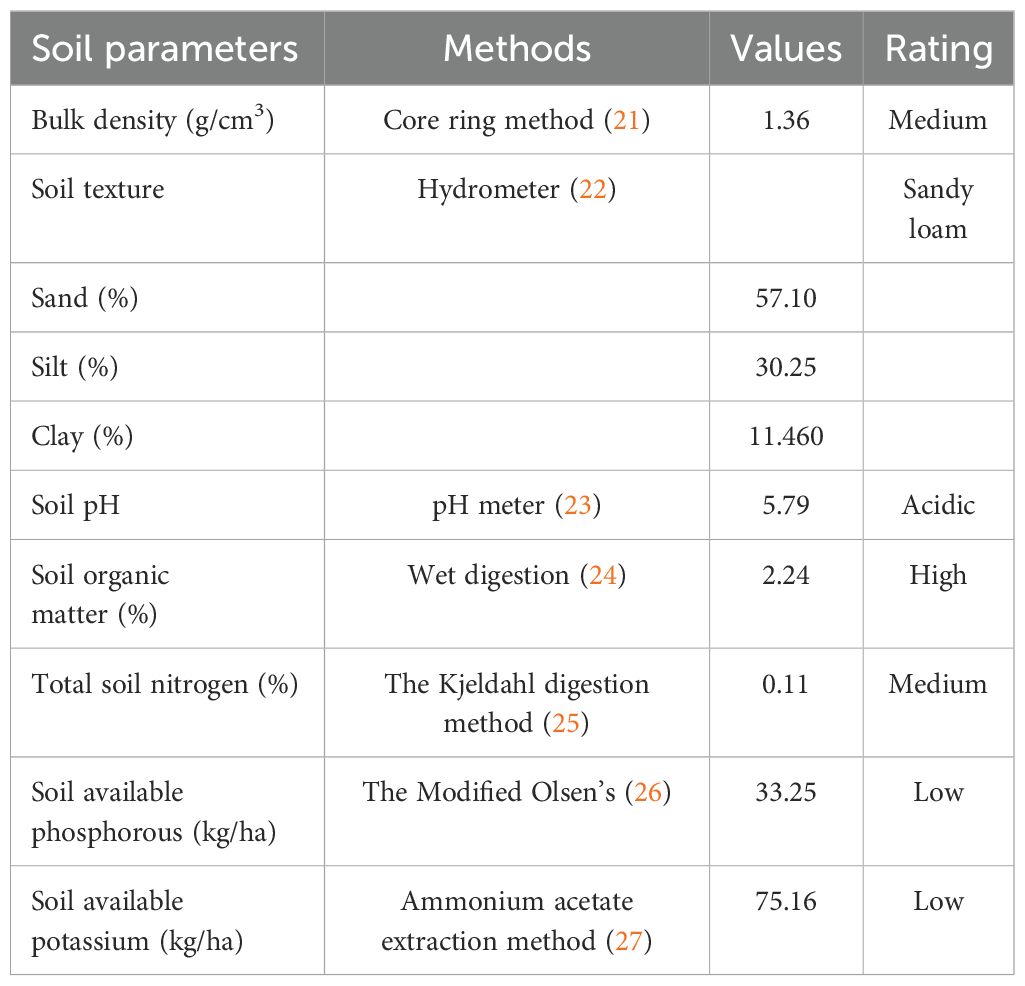
Table 1. Initial physicochemical properties of the experimental site at Padampur, Chitwan, Nepal, 2022.
The experimental site falls under the tropical climate zone of Nepal. The agro-meteorological data were collected from the agro-meteorological station of the National Maize Research Program, Rampur, Chitwan. These agro-meteorological data were maximum air temperature, minimum air temperature, mean temperature, and 24-hour accumulated precipitation The data recorded in the study area over two growing seasons (2022 and 2023) are illustrated in Figure 1. In 2022, March registered the highest mean temperature of 23.1°C, and February recorded the lowest mean temperature of 13.55°C. Furthermore, the maximum and minimum 24-hour accumulated precipitation were observed in January (4 mm) and December (0 mm), respectively. In March 2023, the mean temperature reached its highest point of 24.3°C, whereas February had a minimum mean temperature of 16.85°C. Additionally, the maximum and minimum 24-hour accumulated precipitation were measured in January (3.9 mm) and December (0 mm), respectively. The mean temperature and precipitation during the two growing seasons were suitable for cauliflower production. However, low precipitation levels during the early phase of cauliflower could severely affect the growth and yield of the crop (28).

Figure 1. Maximum, minimum, mean temperature, and 24-hour accumulated precipitation during the cauliflower growing season of 2021–22 (A) and 2022–23 (B).
According to the USDA, the soil had a pH of 5.79, indicating acidity, and had a sandy loam texture (29). indicated that soils with a fine texture contain the highest quantity of accessible P, while soils with a coarse texture have the lowest amount. The optimal bulk density range for sandy loam is 1.55-1.75 g/cm3. Table 1 shows that the soil organic matter content for sandy loam soil typically falls between 2.0% and 2.5%, which is considered high (30). The soil exhibited a moderate level of total nitrogen and a high level of organic matter. However, its accessible potassium and phosphorus levels were found to be low, as reported by (31).
The experiment was carried out for two growing seasons using a Randomized Complete Block Design (RCBD). The entire experimental area was divided into nine treatments viz. T1; Control, T2; Carbon based, T3; Vermicompost, T4; Obifert, T5; Neem seed cake, T6; Poultry manure, T7; Farm yard manure, T8; Mustard oil seed cake and T9; Goat manure with three replications (Table 2). Carbon-based organic fertilizer is produced by blending oil seed cakes, lime, ash, water hyacinth, and bone meal. The utilization of effective bacteria facilitates the process of decomposition. Vermicompost is an organic fertilizer created by the organic matter decomposition carried out by earthworms. Obifert is an organic fertilizer produced through the process of window-aerobic composting. The temperature in the composting process naturally reaches a maximum of 70°C without the need for any chemicals for a specific duration. Towards the end of the composting process, the temperature gradually decreases to 20°C. The materials utilized to create obifert include poultry manure, cow dung, biochar, and forest-derived value products. Neem seeds are processed by crushing them and extracting the oil by methods such as solvent extraction or cold pressing. This oil is then used to produce neem seed cake, which serves as an organic fertilizer. Poultry manure is an organic waste generated by domesticated avian species such as chickens, turkeys, ducks, and so on. FYM is an indigenous organic fertilizer composed of a mixture of animal excrement, bedding material, and decomposing organic refuse. These materials are collected from various livestock species such as horses, goats, sheep, and cattle. Mustard seed oil cake, a residual byproduct of the oil extraction process from mustard seeds, is commonly utilized as an organic fertilizer. Goat dung refers to the waste product generated by domesticated goats, comprising their urine and feces. It is commonly employed as an organic fertilizer to enhance crop development and soil fertility.
The nutrient content, pH, moisture percentage, and amount of organic fertilizers used in the experiment are shown in Table 3.
Each of the 27 experimental plots measured 9 m2 (3m x 3m). The experiment net area was (12 m x 31.5m) 378 m2 (Figure 2A). The Kathmandu local variety of cauliflower was sown and transplanted at 30 DAS. Plants were spaced at 60 cm in between rows and 50 cm in between plants. The spacing between the plots was 0.5 m and between the blocks was 1m. Each plot consisted of 5 rows with 6 plants in each row. The nutrient dose of the organic source was calculated according to the recommended dose of nutrients which is 200:120:80 NPK Kg/ha (32). The central 5 plants were tagged for data collection as shown in Figure 2C. The morphological characteristics of the 5 tagged plants were recorded every 20-day interval starting from 20 days after transplanting till harvesting and their mean was calculated as shown in Figure 2B.
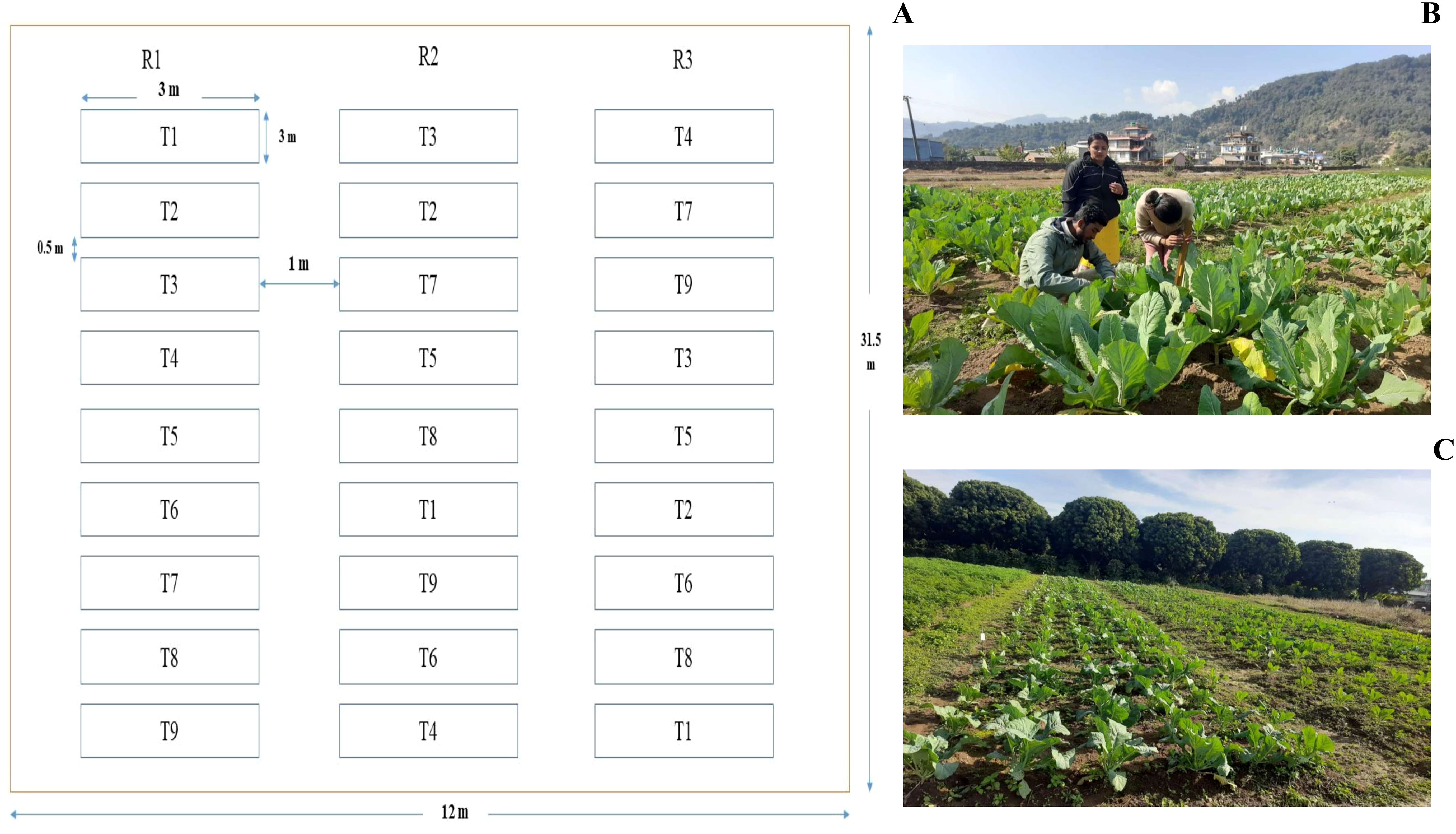
Figure 2. (A) Field layout and randomization of treatment (B) Data collection (C) Experiment site in Chitwan, Nepal in 2022 and 2023.
The cultural practices used during the experiment on cauliflower in two growing seasons are mentioned in Table 4.
After selection of the proper size, the soil was plowed, pulverized, and made into fine tilth. All the grassroots, bricks and stones were collected and thrown out. The bed was prepared and finally leveled. The seeds were sown separately in plots in lines at a depth of about 4 cm. After sowing, the bed was watered with the help of a watering can. Well-prepared FYM was used as manure in the seedbed. After sowing, seeds were covered with a thin film of soil. The sown seedbed was finally covered with a plastic tunnel. Weeds were removed as and when necessary. The seedlings were provided with light irrigation as and when required.
The nursery bed was irrigated a few hours earlier before uprooting the seedlings. Seedlings of five weeks old having 4-5 leaves and of uniform size, well developed, and healthy were uprooted with the utmost care in the afternoon. Plants were carefully observed from 2nd day of transplanting. The sign of permanent wilting and the advent of new growth were considered as indicators of mortality and survival respectively. Exchanging the seedlings showing such mortality symptoms with uniform, healthy, and well-developed seedlings of the same age was done up to 4 days after initial transplanting.
Fertilizers at the rate of 200 kg N, 120 kg P, and 80 kg K per hectare were applied. The total amount of P and K as well as half the amount of N was applied as basal dose, remaining half of nitrogen was applied in two split doses, first at 30 Days after transplanting (DAT) and second at 45 DAT as top dressing and was applied about four inches away from the root zone at a depth of about 2 inches.
Transplanting was followed by irrigation with the help of a watering can in the morning till the plant was established properly. After proper establishment irrigation was given whenever necessary.
Earthing-ups were done twice at 30 DAT and 45 DAT. For earthing up the root zone soil was carefully loosened and proper earthing up was done and it was also accompanied by the removal of weeds.
Harvesting was done when the plants reached the horticultural maturity level and data were collected on the same day of harvesting.
For this study, soil samples were collected three times: once at the beginning of the study and twice during the cauliflower harvest in the years 2022 and 2023. The soil sample was collected at a depth of 0–20 cm by removing the topsoil that was 1 cm deep. This was done using a five-spot sampling procedure for each treatment. We gathered 27 composite soil samples and conveyed them to the laboratory. The soil samples from each treatment were meticulously blended to exclude stones, roots, plastic film debris, and other contaminants. After that, the soil was filtered through a 2 mm sieve. The residual soil was subjected to a controlled drying process in a well-ventilated laboratory setting until it achieved a stable weight. Afterward, its physical and chemical characteristics were analyzed and evaluated.
All plant and soil parameters of the respective crops were recorded and entered in MS Excel. Data validation was carried out in MS Excel. After cleaning, the data were analyzed using R-studio software. The significant differences between the treatments were determined using the least significant difference (LSD) and Duncan’s Multiple Range Test (DMRT) at a 1% or 5% level of significance (33).
The bulk density was not significantly influenced by the application of the organic fertilizers for two consecutive growing seasons. However, the maximum bulk density was observed in the control (1.35 g/cm3) which was followed by carbon-based (1.33 g/cm3). Similarly, the minimum bulk density was recorded in poultry manure, FYM, and goat manure (1.31 g/cm3) as shown in Figure 3A.
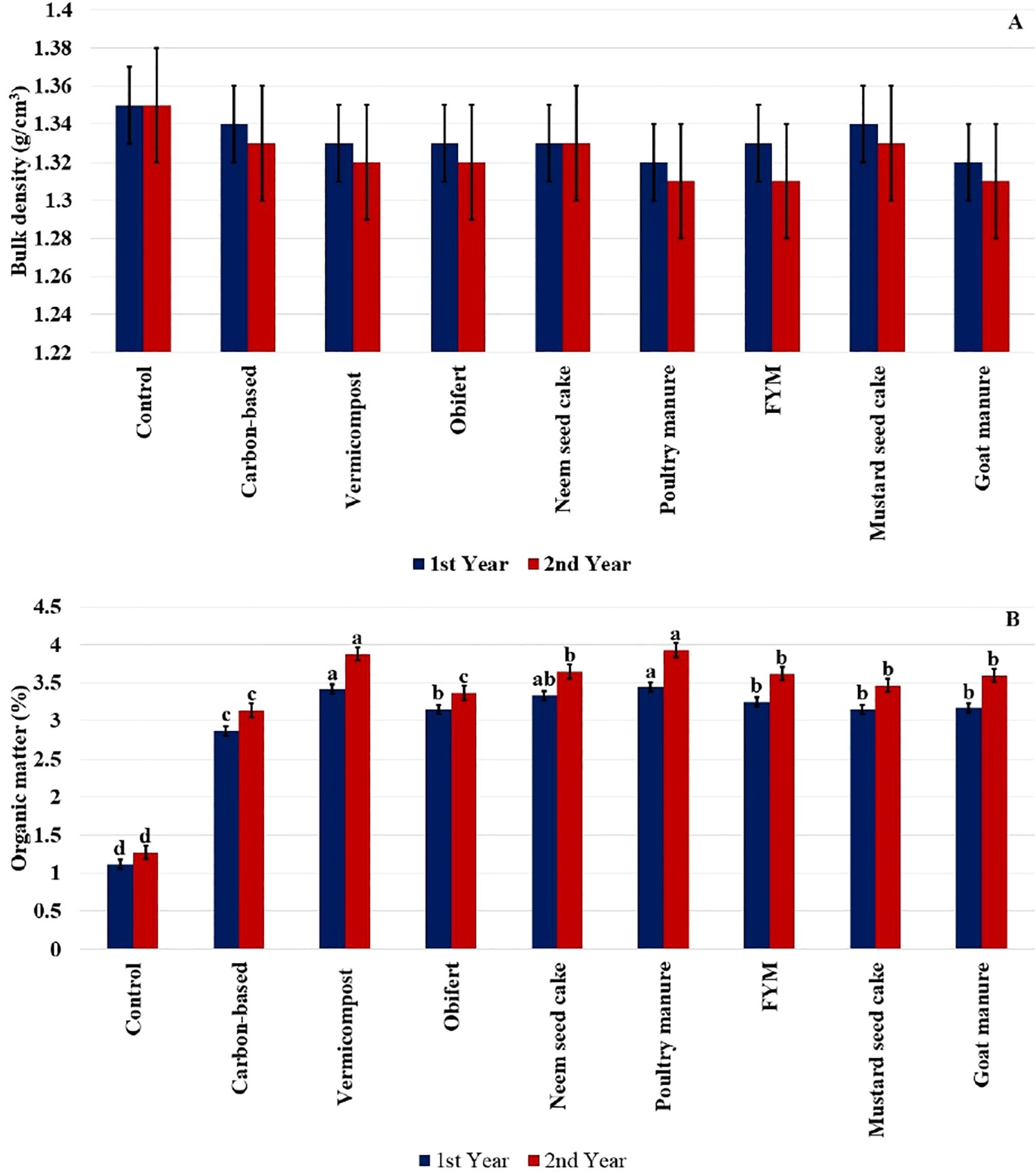
Figure 3. Effect of organic fertilizers on soil bulk density (A) and organic matter (B) during the field experiment in 2022 and 2023. Treatments that share the same (lowercase) letters are not significantly different from each other, while treatments with different letters are significantly different.
From Figure 3A, the application of organic fertilizers significantly improved the soil organic matter, however at the end of the experiment maximum organic matter content in the soil was found in poultry manure (3.93%) followed by vermicompost (3.88%) while the lowest was recorded in control (1.27%) as shown in Figure 3B.
The soil pH was found non-significant in the first year of the experiment, however, it was significantly affected in the second year (Figure 4A). The highest soil pH was recorded from the application of obifert in 1st year (6.60) and 2nd year (6.84) respectively. Similarly, the lowest pH observed was from control in 1st year (6.03) and 2nd year (6.08) respectively as shown in Figure 4A.
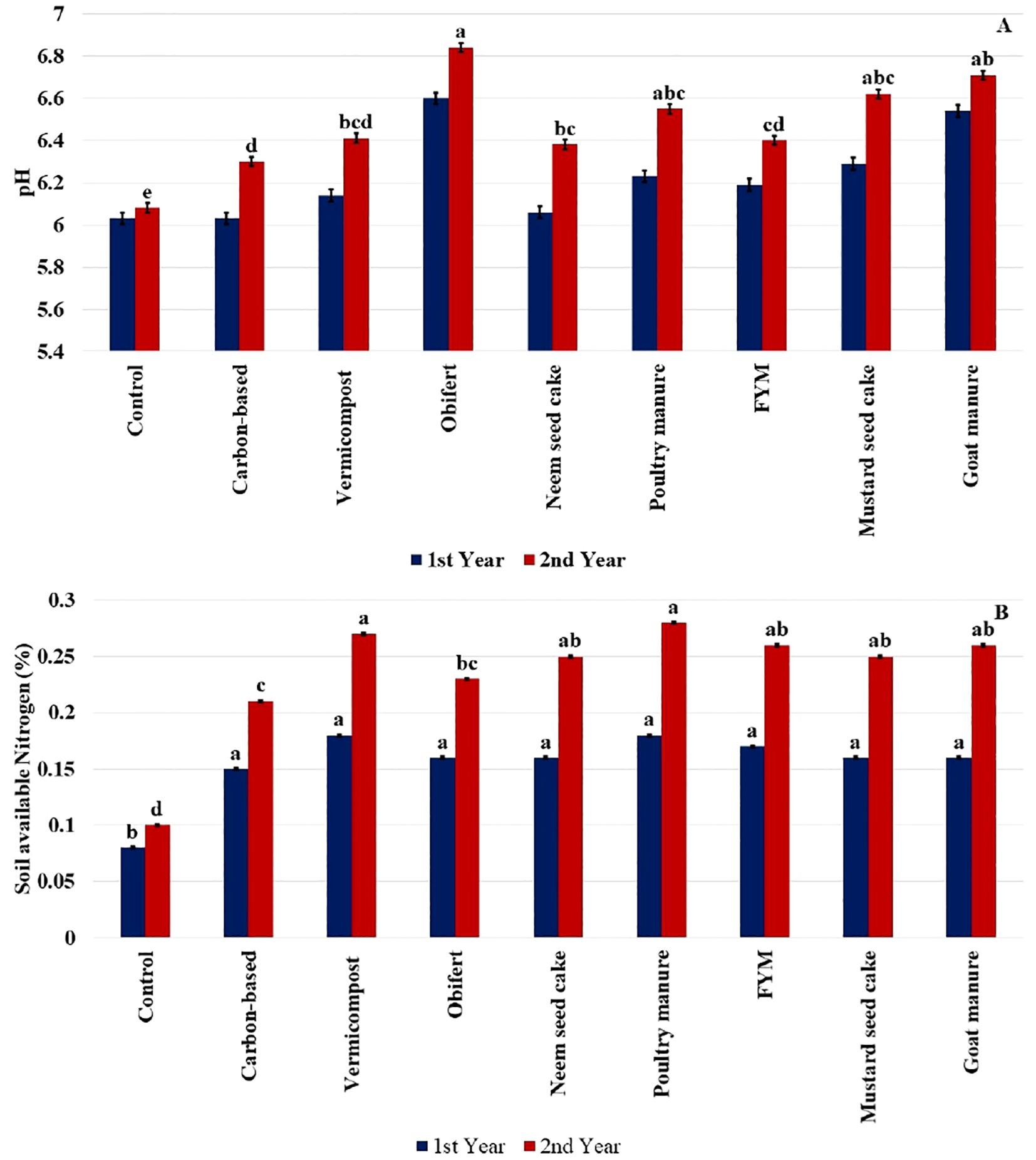
Figure 4. Effect of organic fertilizers on soil pH (A) and soil available nitrogen (B) during the field experiment in 2022 and 2023. Treatments that share the same (lowercase) letters are not significantly different from each other, while treatments with different letters are significantly different.
At the end of two years of the experiment, the application of organic fertilizers significantly improved the soil’s available nitrogen. The highest soil available nitrogen was seen in poultry manure (0.28%) followed by vermicompost (0.27%). The lowest soil available nitrogen was found in the soil treated with control (0.10%) as illustrated in Figure 4B.
The application of organic fertilizers significantly affected the soil’s available phosphorus. The maximum soil available phosphorus was recorded in poultry manure (110.04 Kg/ha) followed by mustard seed cake (104.46 Kg/ha) in 2nd year. Similarly, the minimum soil available phosphorus observed was in control (39.64 Kg/ha) compared to the other treatments as shown in Figure 5A.
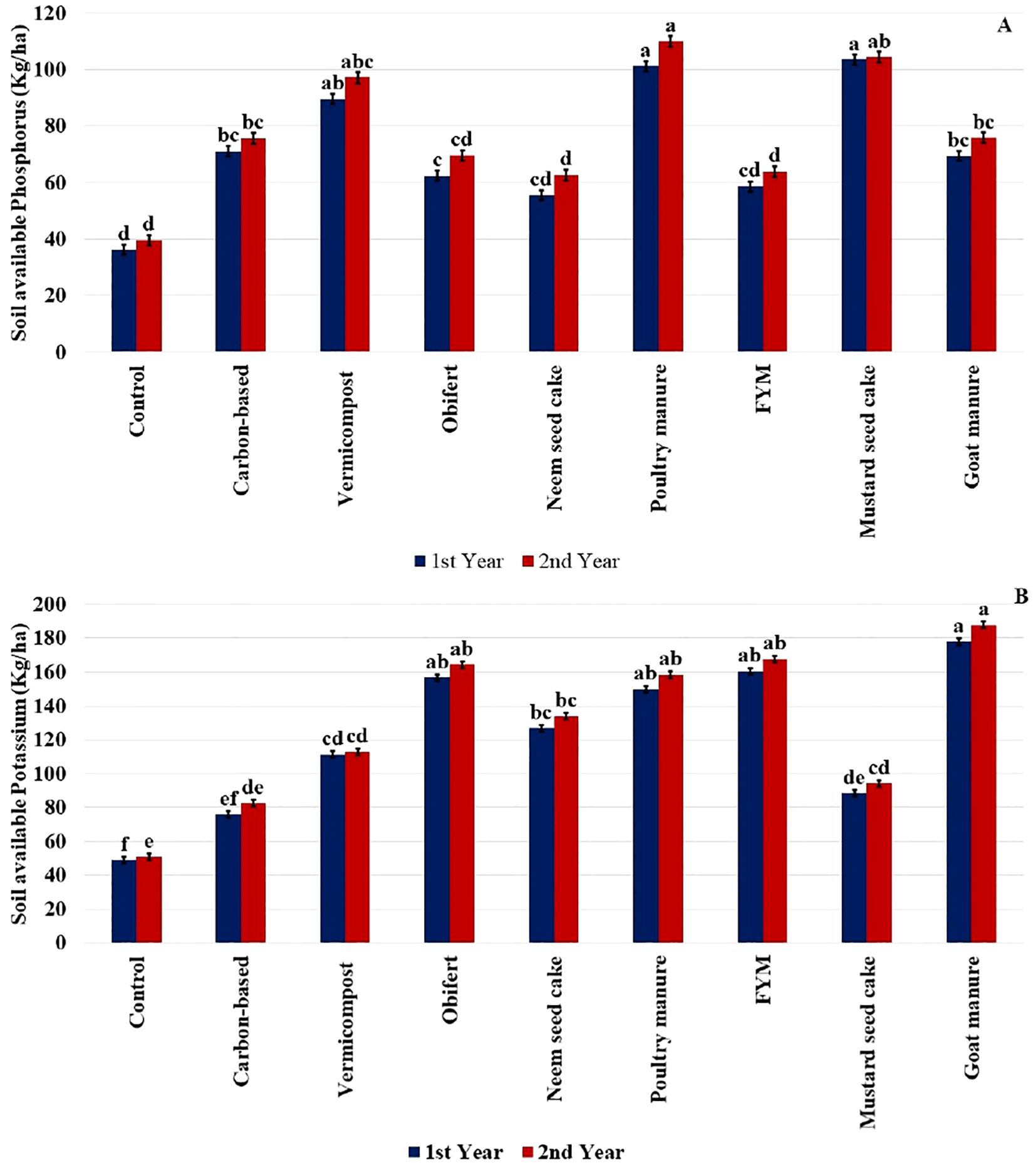
Figure 5. Effect of organic fertilizers on soil-available phosphorus (A) and soil-available potassium (B) during the field experiment in 2022 and 2023. Treatments that share the same (lowercase) letters are not significantly different from each other, while treatments with different letters are significantly different.
There was a significant difference among treatments in the soil available potassium. The highest soil available potassium in 1st year (177.81 Kg/ha) and 2nd year (187.77 Kg/ha) was observed in goat manure followed by FYM in 1st year (160.31 Kg/ha) and 2nd year (167.56 Kg/ha) Likewise, the lowest soil-available potassium in 1st year (48.94 Kg/ha) and 2nd year (50.89 Kg/ha) was recorded in the control as shown in Figure 5B.
Plant height, number of leaves per plant, and length of leaves were significantly influenced by the application of organic fertilizers in both growing years. The highest mean value recorded for plant height was from poultry manure (54.24 cm) followed by neem seed cake (53.41 cm), while the least was recorded from the control (50.23 cm) after two years of experiment. Similarly, the plant treated with FYM (21.00) and control (16.56) had the highest number and lowest number of leaves per plant respectively. The highest length of leaves was observed in poultry manure (42.33 cm) while the lowest was recorded in control (35.16 cm) as illustrated in Table 5.
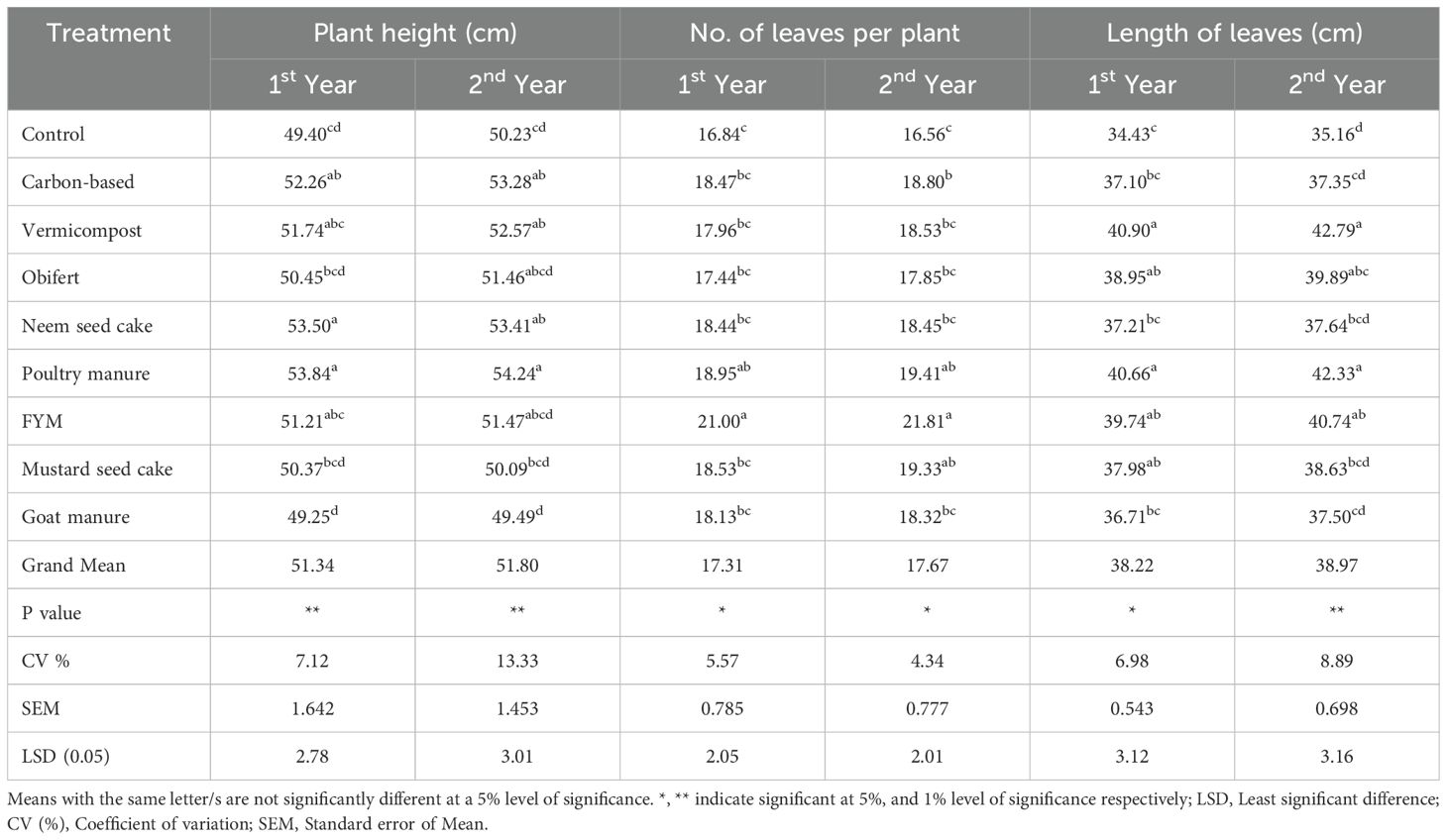
Table 5. Effect of organic manures on growth parameters of cauliflower during the field experiment in 2022 and 2023.
The yield parameters of cauliflower including the diameter of curd, height of curd, and the total yield were significant due to the application of organic fertilizers. After two years of experimentation, the highest diameter of curd was recorded from poultry manure (18.26 cm) followed by obifert (17.99 cm) compared to other treatments. Control (13.76 cm) recorded the lowest diameter of curd at the end of the two-year research. The height of the curd was observed to be highest in poultry manure (11.03 cm) followed by vermicompost (11.01 cm) whereas the lowest height was recorded in control (8.53 cm). Moreover, plants treated with poultry manure (41.91 t/ha) had the highest yield while goat manure (39.85 t/ha) had the lowest yield (Table 6).
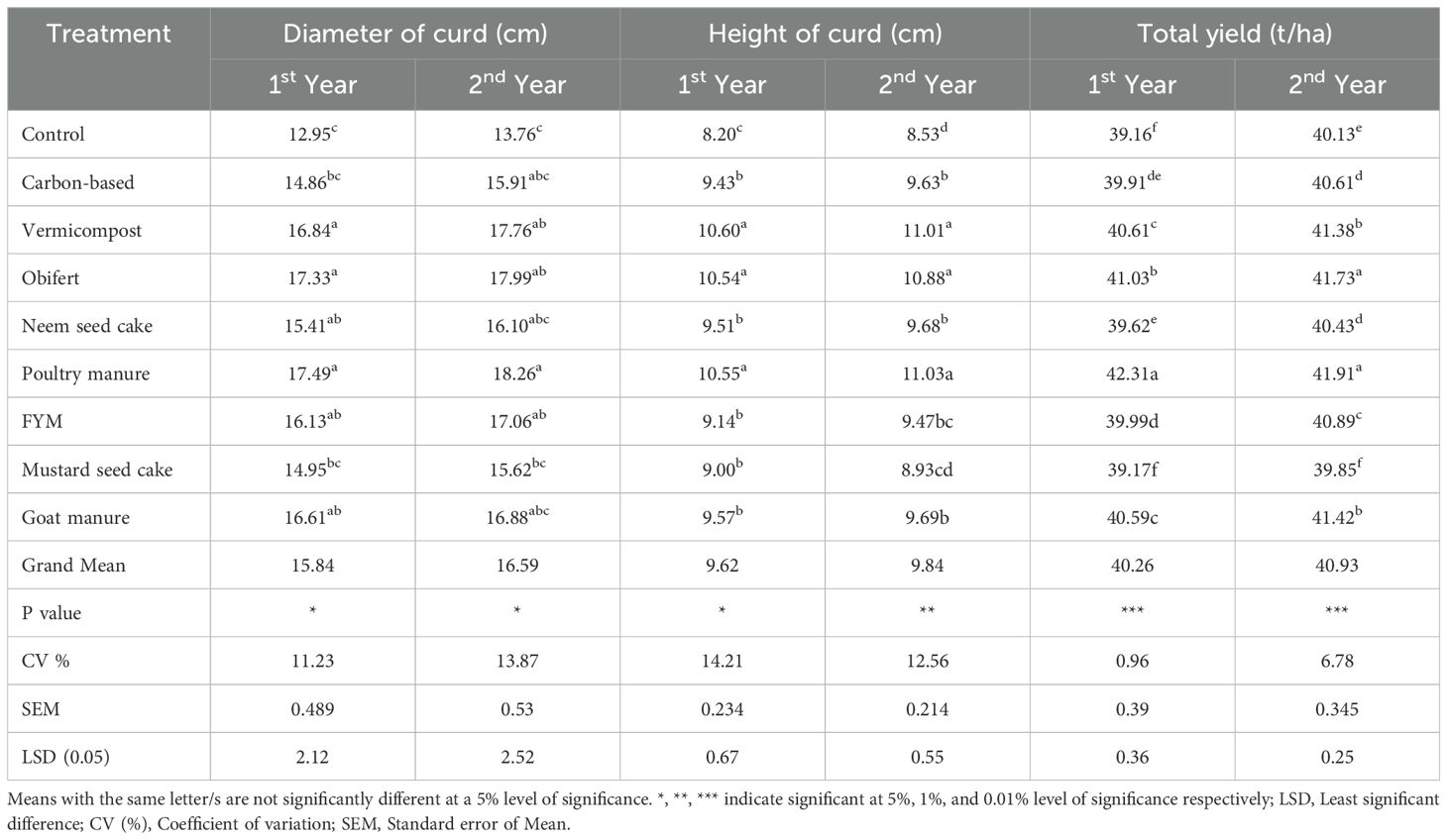
Table 6. Effect of organic manures on yield parameters of cauliflower during the field experiment in 2022 and 2023.
From the result, the bulk density of soil has not been evident, it may be due to improvement of soil structure and porosity of soil requiring longer period of research (Figure 3A). In addition, the decomposition process might not have advanced far enough in such an amount of time to have a major effect on bulk density but a slight decrease in bulk density resulted in an improvement in fertility status (5). Furthermore, it can take a longer duration of time for the impacts of organic matter on the aggregation and structure of the soil to become apparent, even though they may have an impact on bulk density (34, 35).
There is a significant increment of organic matter content in the soil (Figure 3B). It might be due to the poultry fertilizers having a huge amount of complex carbohydrates, lignin, and other organic residues. The addition of decomposable plant and animal components, such as plant debris, animal dung, etc., progressively breaks down and integrates into the soil’s organic matter pool, ultimately raising the amount of organic matter in the soil (36). The soil’s overall organic matter content increases as a result of the decomposition of these organic components, which helps the soil’s stable organic carbon accumulate (37). The initial alkaline nature of organic fertilizers and their high concentration of carboxyl and phenolic functional groups, humic substances may have taken up H+, which could explain the rise in soil pH caused by the addition of organic fertilizers (38).
From the experiment, it can be seen that the nitrogen content in the soil has increased (Figure 4B). It may be due to proteins and other nitrogen-containing substances, such as amines, which are abundant in organic fertilizers. Moreover, when these substances are added to soil, soil microorganisms break them down, releasing nitrogen in the form of nitrates and ammonium (39–41). The available nitrogen content of the soil is increased by these forms of nitrogen, which plants soluble in water easily absorb. Organic matter in organic fertilizer also improves soil fertility and microbial activity, which helps convert organic nitrogen into forms that plants can use (10, 42).
The phosphorus in the soil is seen to increase (Figure 5A). It might be due to the addition of orthophosphate (H2PO4- and H2PO42-).The organic compounds in poultry manure undergo mineralization, solubilization, and chelation processes, which convert the phosphorus into plant-available forms (43, 44). Additionally, the pH-adjusting effect of poultry manure can further enhance the availability of phosphorus in the soil (45). A similar kind of result was observed when poultry manure was applied in the soil (46).
In the study, goat manure played a crucial role in the increase of soil available potassium content (Figure 5B). It may be due to the richness of water-soluble potassium and the enhancement of the cation exchange capacity of soil. Application of goat manure to sandy loam soil enhanced its potassium concentration and release into the soil (47, 48). As organic fertilizers break down, some of the potassium-containing minerals in the soil dissolve due to the action of organic acids such as fulvic and humic acids (29). This causes the potassium ions to be released into the soil and raises their concentration in the soil solution (49).
From the experiment, poultry manure helped to increase the plant height of cauliflower (Table 5). It might be due to the increase of microbial activity in the soil which enhances nutrient mineralization. Poultry manure gives cauliflower plants the right amount of nitrogen, phosphorus, and potassium, these three elements that are essential to their growth (50). These nutrients promote strong stem elongation, which in turn leads to taller cauliflower plants by increasing cellular activity and chlorophyll production (51).
Farmyard manure increased the number of leaves in cauliflower (Table 5). It may be due to farmyard manure provides natural nutrition since it is rich in organic matter and minerals. Additionally, slow nutrient release from its breakdown guarantees a consistent supply for leaf growth (52, 53). Furthermore, the microbial activity it stimulates improves soil health, making it easier for roots to penetrate and absorb nutrients, which in turn encourages the creation of leaves (54).
The vermicompost helped to increase the length of the leaves of cauliflower (Table 5). It might be due to the humus content in the soil which is extracted by earthworms that contain humic acid. The tea-like structure of vermicompost may have increased the porosity, water-holding capacity, and nutrient availability (35, 55). Furthermore, the availability of nutrients that promote plant growth and increase the length of cauliflower leaves (56).
From the study, vermicompost helped to enhance the curd size of cauliflower (Table 6). It may be due to the presence of beneficial bacteria in vermicompost aids in the plant’s uptake of nutrients and ensures that the nutrients are used effectively for the creation of curd (57). Vermicompost also improves the cation exchange capacity and ability to hold water, which helps for the ideal environment for curd height of cauliflower (58).
Poultry manure played a crucial role in the increase of curd diameter of cauliflower (Table 6). It might be due to the rich source of minerals, especially phosphorus and potassium. These nutrients are crucial for curd growth and enlargement, it have a substantial impact on cauliflower curd diameter (59). Larger curd diameters in cauliflower plants are produced by the steady release of these nutrients from poultry manure (19).
The application of poultry manure increased the yield of cauliflower (Table 6). It may be due to the poultry manure provides essential nutrients, which improves the crop yield. The addition of vital nutrients like nitrogen, phosphorus, potassium, etc. is necessary for plant growth and development, which ultimately leads to an increase in yield (60, 61). Additionally, improved soil fertility brought about by its organic content encourages root growth and nutrient uptake, both of which increase cauliflower yields (62). A similar kind of result was found in the study of vegetables (63).
It was concluded that applying poultry manure at a rate of 4.63 t/ha improves cauliflower yield and performance. Compared to other organic and inorganic fertilizers, soils treated with poultry manure showed higher levels of organic matter content, favorable soil pH level, total soil nitrogen, and soil available phosphorus. Adoption of poultry manure showed higher efficiency in increasing crop sustainability and general soil health when viewed holistically. Adding organic fertilizers improves the soil quality and creates an atmosphere that allows cauliflower plants to have better access to nutrients. So, adding poultry manure turns out to be an alternative way to maximize the yield of cauliflower while also improving soil fertility and sustainability.
The original contributions presented in the study are included in the article/supplementary material. Further inquiries can be directed to the corresponding author.
VG: Conceptualization, Data curation, Formal Analysis, Investigation, Methodology, Software, Supervision, Validation, Writing – original draft, Writing – review & editing. JC: Conceptualization, Data curation, Formal Analysis, Investigation, Methodology, Software, Supervision, Writing – original draft, Writing – review & editing. RD: Data curation, Formal Analysis, Methodology, Software, Writing – original draft, Writing – review & editing. BP: Investigation, Methodology, Validation, Visualization, Writing – original draft, Writing – review & editing.
The author(s) declare that no financial support was received for the research and/or publication of this article.
The authors extend their appreciation to the Agriculture and Forestry University Chitwan Nepal, for their generous ideas of research facilities.
The authors declare that the research was conducted in the absence of any commercial or financial relationships that could be construed as a potential conflict of interest.
The author(s) declare that no Generative AI was used in the creation of this manuscript.
All claims expressed in this article are solely those of the authors and do not necessarily represent those of their affiliated organizations, or those of the publisher, the editors and the reviewers. Any product that may be evaluated in this article, or claim that may be made by its manufacturer, is not guaranteed or endorsed by the publisher.
1. Shukla AK, Behera SK, Chaudhari SK, Singh G. Fertilizer use in Indian agriculture and its impact on human health and environment. Indian J Fertil. (2022) 18:218–37.
2. AbdelRahman MA, Metwaly MM, Afifi AA, D’Antonio P, Scopa A. Assessment of soil fertility status under soil degradation rate using geomatics in West Nile Delta. Land. (2022) 11:1256. doi: 10.3390/land11081256
3. Verma BC, Pramanik P, Bhaduri D. Organic fertilizers for sustainable soil and environmental management. Nutrient dynamics Sustain Crop production. (2020), 289–313. doi: 10.1007/978-981-13-8660-2_10
4. Craswell E. Fertilizers and nitrate pollution of surface and ground water: an increasingly pervasive global problem. SN Appl Sci. (2021) 3:518. doi: 10.1007/s42452-021-04521-8
5. Shaji H, Chandran V, Mathew L. Organic fertilizers as a route to controlled release of nutrients. In: Controlled release fertilizers for sustainable agriculture. Amsterdam, Netherlands: Academic Press (2021). p. 231–45. doi: 10.1016/B978-0-12-819555-0.00013-3
6. Ghimirey V, Chaurasia J, Acharya N, Dhungana R, Chaurasiya S. Biofertilizers: A sustainable strategy for enhancing physical, chemical, and biological properties of soil. Innov Agriculture. (2024) 7:1–1. doi: 10.3897/ia.2024.128697
7. Dhaliwal SS, Naresh RK, Mandal A, Walia MK, Gupta RK, Singh R, et al. Effect of manures and fertilizers on soil physical properties, build-up of macro and micronutrients and uptake in soil under different cropping systems: a review. J Plant Nutr. (2019) 42:2873–900. doi: 10.1080/01904167.2019.1659337
8. Sharma R, Kandel S, Khadka S, Chaudhary S. Nutrient contents in different sources of organic manures used in different farms of Bhaktapur district, Nepal. J Agric Natural Resources. (2022) 5:150–6. doi: 10.3126/janr.v5i1.50705
9. Dahal S, Manandhar B. Soil management practices in commercial vegetable farming in changing socioeconomic context in Makawanpur, Nepal. Environ Challenges. (2021) 4:100188. doi: 10.1016/j.envc.2021.100188
10. Singh TB, Ali A, Prasad M, Yadav A, Shrivastav P, Goyal D, et al. Role of organic fertilizers in improving soil fertility. Contaminants agriculture: sources impacts Manage. (2020), 61–77. doi: 10.1007/978-3-030-41552-5_3
11. Khan MT, Aleinikovienė J, Butkevičienė LM. Innovative organic fertilizers and cover crops: Perspectives for sustainable agriculture in the era of climate change and organic agriculture. Agronomy. (2024) 14:2871. doi: 10.3390/agronomy14122871
12. Subedi R, Karki M, Panday D. Food system and water–energy–biodiversity nexus in Nepal: a review. Agronomy. (2020) 10:1129. doi: 10.3390/agronomy10081129
13. Simarmata M, Susanti L, Setyowati N. Utilization of manure and green organic composts as alternative fertilizers for cauliflower production. J Agric Technol. (2016) 12:311–9.
14. Ramos MC, Martínez-Casasnovas JA. Erosion rates and nutrient losses affected by composted cattle manure application in vineyard soils of NE Spain. Catena. (2006) 68:177–85. doi: 10.1016/j.catena.2006.04.004
15. Ghimirey V, Chaurasia J, Acharya N, Marahatta S, Devkota K. Soil properties and yield of mung bean [VIGNA RADIATA (L.) WILCZEK] as influenced by tillage and phosphorous fertilizer management on sandy loam soil in Chitwan, Nepal. J Saudi Soc Agric Sci. (2024). doi: 10.1016/j.jssas.2024.10.001
16. Siedt M, Schäffer A, Smith KE, Nabel M, Roß-Nickoll M, Van Dongen JT. Comparing straw, compost, and biochar regarding their suitability as agricultural soil amendments to affect soil structure, nutrient leaching, microbial communities, and the fate of pesticides. Sci Total Environment. (2021) 751:141607. doi: 10.1016/j.scitotenv.2020.141607
17. Belitz HD, Grosch W, Schieberle P, Belitz HD, Grosch W, Schieberle P. Vegetables and vegetable products. Food Chem. (2004), 772–805. doi: 10.1007/978-3-662-07279-0_18
18. Ministry of Agriculture and Livestock Development. Statistical Information on NEPALese Agriculture. Kathmandu: Ministry of Agriculture and Livestock Development (2019). Available at: https://moald.gov.np/publication-types/agriculture-statistics/ (Accessed December 18, 2024).
19. Neupane B, Aryal K, Chhetri LB, Regmi S. Effects of integrated nutrient management in early season cauliflower production and its residual effects on soil properties. J Agric Natural Resources. (2020) 3:353–65. doi: 10.3126/janr.v3i2.32548
20. Rashmi I, Roy T, Kartika KS, Pal R, Coumar V, Kala S, et al. Organic and inorganic fertilizer contaminants in agriculture: Impact on soil and water resources. Contaminants Agriculture: Sources Impacts Manage. (2020), 3–41. doi: 10.1007/978-3-030-41552-5_1
21. Klute A, Dirksen C. Hydraulic conductivity and diffusivity: Laboratory methods. Methods Soil analysis: Part 1 Phys mineralogical Methods. (1986) 5:687–734. doi: 10.2136/sssabookser5.1.2ed.c28
22. Blake GR, Hartage KH. Bulk density. Methods of soil analysis. Part 1. Physical and mineralogical methods, A klute (ed). Am Soc Agron. (1986) 101:365–75.
23. Cottenie A, Verloo M, Kiekens L, Velghe G, Camerlynck R. Chemical analysis of plants and soils. Lab Agroch. State Univ Gent Belgium. (1982) 63:44–5.
24. Estefan G. Methods of soil, plant, and water analysis: a manual for the West Asia and North Africa region. International Center for Agricultural Research in the Dry Areas. (2013).
25. Bremner JM, Mulvaney CS. Nitrogen—total. Methods Soil analysis: Part 2 Chem microbiological properties. (1982) 9:595–624. doi: 10.2134/agronmonogr9.2.2ed.c31
27. Pratt PF. Methods of soil analysis. Part 2. Chemical and microbiological properties Vol. 9. Black CA, editor. Madison, Wisconsin, USA: Amer. Soc. Agr. Inc. Pub. Agron. Series (1965).
28. Bozkurt S, Uygur V, Agca N, Yalcin M. Yield responses of cauliflower (Brassica oleracea L. var. Botrytis) to different water and nitrogen levels in a Mediterranean coastal area. Acta Agriculturae Scandinavica Section B–Soil Plant Science. (2011) 61:183–94. doi: 10.1080/09064710.2010.539575
29. Rawat J, Sanwal P, Saxena J. Towards the mechanisms of nutrient solubilization and fixation in soil system. In: Role of Rhizospheric Microbes in Soil: Volume 2: Nutrient Management and Crop Improvement. Amsterdam, Netherlands: Springer (2018). p. 229–57. doi: 10.1007/978-981-13-0044-8_8
30. Bhattarai S, Bhatta S, Shriswastav CP, Subedi J. Effect of Organic Source of Nutrients on Soil Physico-Chemical Properties, Growth and Yield of Cabbage (Brassica oleracea var. capitata). Asian J Soil Sci. Plant Nutr. (2023) 9:45–55. doi: 10.9734/ajsspn/2023/v9i1171
31. Rawal N, Pande KR, Shrestha R, Vista SP. Phosphorus and potassium mineralization as affected by phosphorus levels and soil types under laboratory condition. Agrosystems Geosciences Environment. (2022) 5:e20229. doi: 10.1002/agg2.20229
32. Timilsina S, Khanal A, Vista SP, Poon TB. Effect of biochar application in combination with different nutrient sources on cauliflower production at kaski Nepal. J Agric Environ. (2021) 21:82–9. doi: 10.3126/aej.v21i0.38444
33. Gomez KA, Gomez AA. Statistical procedures for agricultural research. New York, USA: John wiley & sons (1984).
34. Hati KM, Swarup A, Mishra B, Manna MC, Wanjari RH, Mandal KG, et al. Impact of long-term application of fertilizer, manure and lime under intensive cropping on physical properties and organic carbon content of an Alfisol. Geoderma. (2008) 148:173–9. doi: 10.1016/j.geoderma.2008.09.015
35. Marahatta S, Chaurasia J, Ghimirey V, Dahal SR. Beneath the surface: Earthworms and their beneficial impacts on farming communities. Rev In Food Agriculture. (2024) 5:06–12. doi: 10.26480/rfna.01.2024.06.12
36. Antil RS, Singh M. Effects of organic manures and fertilizers on organic matter and nutrients status of the soil. Arch Agron Soil Science. (2007) 53:519–28. doi: 10.1080/03650340701571033
37. Menšík L, Hlisnikovský L, Pospíšilová L, Kunzová E. The effect of application of organic manures and mineral fertilizers on the state of soil organic matter and nutrients in the long-term field experiment. J soils sediments. (2018) 18:2813–22. doi: 10.1007/s11368-018-1933-3
38. Mockeviciene I, Repsiene R, Amaleviciute-Volunge K, Karcauskiene D, Slepetiene A, Lepane V. Effect of long-term application of organic fertilizers on improving organic matter quality in acid soil. Arch Agron Soil Science. (2022) 68:1192–204. doi: 10.1080/03650340.2021.1875130
39. Debono O, Villot A. Nitrogen products and reaction pathway of nitrogen compounds during the pyrolysis of various organic wastes. J Analytical Appl pyrolysis. (2015) 114:222–34. doi: 10.1016/j.jaap.2015.06.002
40. Zilio M, Motta S, Tambone F, Scaglia B, Boccasile G, Squartini A, et al. The distribution of functional N-cycle related genes and ammonia and nitrate nitrogen in soil profiles fertilized with mineral and organic N fertilizer. PloS One. (2020) 15:e0228364. doi: 10.1371/journal.pone.0228364
41. Chaurasia J, Poudel B, Mandal T, Acharya N, Ghimirey V. Effect of micronutrients, rhizobium, salicylic acid, and effective microorganisms in plant growth and yield characteristics of green gram [Vigna radiata (L.) Wilczek] in Rupandehi, Nepal. Heliyon. (2024) 10:1–11. doi: 10.1016/j.heliyon.2024.e26821
42. Ghimirey V, Chaurasia J, Marahatta S. Plant nutrition disorders: insights from clinic analyses and their impact on plant health. Agric Extension Developing Countries. (2024) 2:09–17. doi: 10.26480/aedc.01.2024.09.17
43. Guppy CN, Menzies NW, Moody PW, Blamey FP. Competitive sorption reactions between phosphorus and organic matter in soil: a review. Soil Res. (2005) 43:189–202. doi: 10.1071/SR04049
44. Walpola BC, Hettiarachchi RH. Organic manure amended with phosphate solubilizing bacteria on soil phosphorous availability. J Agric Sci (Sri Lanka). (2020) 15:142–53. doi: 10.4038/jas.v15i2.8796
45. Zhu J, Li M, Whelan M. Phosphorus activators contribute to legacy phosphorus availability in agricultural soils: A review. Sci Total Environment. (2018) 612:522–37. doi: 10.1016/j.scitotenv.2017.08.095
46. Adnan M, Fahad S, Khan IA, Saeed M, Ihsan MZ, Saud S, et al. Integration of poultry manure and phosphate solubilizing bacteria improved availability of Ca bound P in calcareous soils. 3 Biotech. (2019) 9:1–0. doi: 10.1007/s13205-019-1894-2
47. Saka HA, Azeez JO, Odedina JN, Akinsete SJ. Dynamics of soil nitrogen availability indices in a sandy clay loam soil amended with animal manures. Int J Recycling Organic Waste Agriculture. (2017) 6:167–78. doi: 10.1007/s40093-017-0165-7
48. Ghimirey V, Chaurasia J, Acharya N, Dhungana R, Marahatta S. Nurturing earth's foundation: A comprehensive review of soil conservation strategies, challenges and solutions. AgroEnvironmental Sustainability. (2024) 2:139–50. doi: 10.59983/s2024020305
49. Kumar Sootahar M, Zeng X, Su S, Wang Y, Bai L, Zhang Y, et al. The effect of fulvic acids derived from different materials on changing properties of albic black soil in the Northeast Plain of China. Molecules. (2019) 24:1535. doi: 10.3390/molecules24081535
50. Farhad W, Saleem MF, Cheema MA, Hammad HM. Effect of poultry manure levels on the productivity of spring maize (Zea mays L.). J Anim. Plant Sci. (2009) 19:122–5.
51. Sinha D, Tandon PK. An overview of nitrogen, phosphorus and potassium: Key players of nutrition process in plants. Sustain solutions elemental deficiency excess Crop Plants. (2020), 85–117. doi: 10.1007/978-981-15-8636-1_5
52. Kalbitz K, Schmerwitz J, Schwesig D, Matzner E. Biodegradation of soil-derived dissolved organic matter as related to its properties. Geoderma. (2003) 113:273–91. doi: 10.1016/S0016-7061(02)00365-8
53. Nawab J, Ghani J, Ullah S, Ahmad I, Akbar Jadoon S, Ali S, et al. Influence of agro-wastes derived biochar and their composite on reducing the mobility of toxic heavy metals and their bioavailability in industrial contaminated soils. Int J Phytoremediation. (2024) 26:1–15. doi: 10.1080/15226514.2024.2357640
54. Semenov MV, Krasnov GS, Semenov VM, Ksenofontova N, Zinyakova NB, van Bruggen AH. Does fresh farmyard manure introduce surviving microbes into soil or activate soil-borne microbiota? J Environ Manage. (2021) 294:113018. doi: 10.1016/j.jenvman.2021.113018
55. Atiyeh RM, Lee S, Edwards CA, Arancon NQ, Metzger JD. The influence of humic acids derived from earthworm-processed organic wastes on plant growth. Bioresource technology. (2002) 84:7–14. doi: 10.1016/S0960-8524(02)00017-2
56. Reza S, Babul Akter M, Rahman M, Ali I, Bulbul Ahmed M. Impact of organic and inorganic fertilizers on yield and yield contributing characters of mustard (Brassica napus L.). Asian J Soil Sci Plant Nutr. (2022) 8:27–34. doi: 10.9734/ajsspn/2022/v8i130131
57. Kumar V, Kumar Y, Tyagi AK, Singh B, Kumar N. Effect of vermicompost and VAM inoculation on growth and yield of cauliflower (Brassica oleracea var. Botrytis L.). Progressive Agriculture. (2010) 10:197–9.
58. Lim SL, Wu TY, Lim PN, Shak KP. The use of vermicompost in organic farming: overview, effects on soil and economics. J Sci Food Agriculture. (2015) 95:1143–56. doi: 10.1002/jsfa.6849
59. Islam MR, Hoque TS, Khan RN, Farzana S, Ahmed M, Khodabakhshloo N. Influence of different integrated nutrient management strategies on growth, yield and nutritional qualities of cauliflower. Agric Res. (2021) 10:656–64. doi: 10.1007/s40003-020-00527-7
60. Shanta UK, Howlader MH, Hasan MM, Nabi A, Ratna SA. Effect of fertilizers and manures on the growth and yield of cauliflower. Intl J Chem Stud. (2018) 8:1196–200.
61. Taj A, Bibi H, Akbar WA, Rahim HU, Iqbal M, Ullah S. Effect of poultry manure and NPK compound fertilizer on soil physicochemical parameters, NPK availability, and uptake by spring maize (Zea mays L.) in alkaline-calcareous soil. Gesunde Pflanzen. (2023) 75:393–403. doi: 10.1007/s10343-022-00710-6
62. Rayne N, Aula L. Livestock manure and the impacts on soil health: A review. Soil Systems. (2020) 4:64. doi: 10.3390/soilsystems4040064
Keywords: curd diameter, farm yard manure, organic matter, poultry manure, soil pH
Citation: Ghimirey V, Chaurasia J, Dhungana R and Poudel B (2025) Organic fertilizers and their efficacy on soil characteristics, growth and yield of cauliflower (Brassica oleraceae var. botrytis) in sandy loam soil of Nepal. Front. Soil Sci. 5:1556283. doi: 10.3389/fsoil.2025.1556283
Received: 06 January 2025; Accepted: 28 February 2025;
Published: 24 March 2025.
Edited by:
Mohammad Bagher Hassanpouraghdam, University of Maragheh, IranReviewed by:
Sajid Ullah, Nangarhar University, AfghanistanCopyright © 2025 Ghimirey, Chaurasia, Dhungana and Poudel. This is an open-access article distributed under the terms of the Creative Commons Attribution License (CC BY). The use, distribution or reproduction in other forums is permitted, provided the original author(s) and the copyright owner(s) are credited and that the original publication in this journal is cited, in accordance with accepted academic practice. No use, distribution or reproduction is permitted which does not comply with these terms.
*Correspondence: Jay Chaurasia, amF5Y2hhdXJhc2lhODJAZ21haWwuY29t
Disclaimer: All claims expressed in this article are solely those of the authors and do not necessarily represent those of their affiliated organizations, or those of the publisher, the editors and the reviewers. Any product that may be evaluated in this article or claim that may be made by its manufacturer is not guaranteed or endorsed by the publisher.
Research integrity at Frontiers

Learn more about the work of our research integrity team to safeguard the quality of each article we publish.